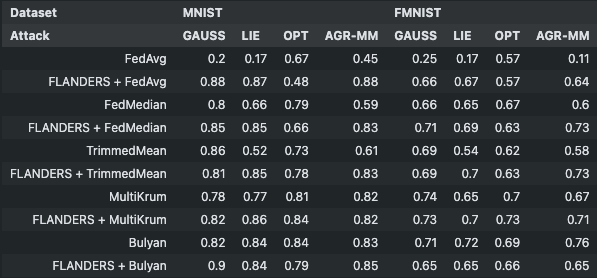FLANDERS: Protecting Federated Learning from Extreme Model Poisoning Attacks via Multidimensional Time Series Anomaly Detection¶
Note: If you use this baseline in your work, please remember to cite the original authors of the paper as well as the Flower paper.
Paper: arxiv.org/abs/2303.16668
Authors: Edoardo Gabrielli, Gabriele Tolomei, Dimitri Belli, Vittorio Miori
Abstract: Current defense mechanisms against model poisoning attacks in federated learning (FL) systems have proven effective up to a certain threshold of malicious clients. In this work, we introduce FLANDERS, a novel pre-aggregation filter for FL resilient to large-scale model poisoning attacks, i.e., when malicious clients far exceed legitimate participants. FLANDERS treats the sequence of local models sent by clients in each FL round as a matrix-valued time series. Then, it identifies malicious client updates as outliers in this time series by comparing actual observations with estimates generated by a matrix autoregressive forecasting model maintained by the server. Experiments conducted in several non-iid FL setups show that FLANDERS significantly improves robustness across a wide spectrum of attacks when paired with standard and robust existing aggregation methods.
About this baseline¶
What’s implemented: The code in this directory replicates the results of FLANDERS+[baseline] on MNIST and Fashion-MNIST under all attack settings: Gaussian, LIE, OPT, and AGR-MM; with \(r=[0.2,0.6,0.8]\) (i.e., the fraction of malicious clients), specifically about tables 1, 3, 10, 11, 15, 17, 19, 20 and Figure 3.
Datasets: MNIST, FMNIST
Hardware Setup: AMD Ryzen 9, 64 GB RAM, and an NVIDIA 4090 GPU with 24 GB VRAM.
Estimated time to run: You can expect to run experiments on the given setup in 2m with MNIST and 3m with Fashion-MNIST, without attacks. With an Apple M2 Pro, 16gb RAM, each experiment with 10 clients for MNIST runs in about 24 minutes. Note that experiments with OPT (fang) and AGR-MM (minmax) can be up to 5x times slower.
Contributors: Edoardo Gabrielli, Sapienza University of Rome (GitHub, Scholar)
Experimental Setup¶
Please, checkout Appendix F and G of the paper for a comprehensive overview of the hyperparameters setup, however here’s a summary.
Task: Image classification
Models:
MNIST (multilabel classification, fully connected, feed forward NN):
Multilevel Perceptron (MLP)
minimizing multiclass cross-entropy loss using Adam optimizer
input: 784
hidden layer 1: 128
hidden layer 2: 256
Fashion-MNIST (multilabel classification, fully connected, feed forward NN):
Multilevel Perceptron (MLP)
minimizing multiclass cross-entropy loss using Adam optimizer
input: 784
hidden layer 1: 256
hidden layer 2: 128
hidden layer 3: 64
Dataset: Every dataset is partitioned into two disjoint sets: 80% for training and 20% for testing. The training set is distributed across all clients (100) by using the Dirichlet distribution with \(\alpha=0.5\), simulating a high non-i.i.d. scenario, while the testing set is uniform and held by the server to evaluate the global model.
Description |
Default Value |
|---|---|
Partitions |
100 |
Evaluation |
centralized |
Training set |
80% |
Testing set |
20% |
Distribution |
Dirichlet |
\(\alpha\) |
0.5 |
Training Hyperparameters:
Dataset |
# of clients |
Clients per round |
# of rounds |
Batch size |
Learning rate |
Optimizer |
Dropout |
Alpha |
Beta |
# of clients to keep |
Sampling |
|---|---|---|---|---|---|---|---|---|---|---|---|
MNIST |
100 |
100 |
50 |
32 |
\(10^{-3}\) |
Adam |
0.2 |
0.0 |
0.0 |
\(m - b\) |
500 |
FMNIST |
100 |
100 |
50 |
32 |
\(10^{-3}\) |
Adam |
0.2 |
0.0 |
0.0 |
\(m - b\) |
500 |
Where \(m\) is the number of clients partecipating during n-th round and \(b\) is the number of malicious clients. The variable \(sampling\) identifies how many parameters MAR analyzes.
Environment Setup¶
# Use a version of Python >=3.9 and <3.12.0.
pyenv local 3.10.12
poetry env use 3.10.12
# Install everything from the toml
poetry install
# Activate the env
poetry shell
Running the Experiments¶
Ensure that the environment is properly set up, then run:
python -m flanders.main
To execute a single experiment with the default values in conf/base.yaml.
To run custom experiments, you can override the default values like that:
python -m flanders.main dataset=mnist server.attack_fn=lie server.num_malicious=1
To run multiple custom experiments:
python -m flanders.main --multirun dataset=mnist,fmnist server.attack_fn=gaussian,lie,fang,minmax server.num_malicious=0,1,2,3,4,5
Expected Results¶
To run all the experiments of the paper (for MNIST and Fashion-MNIST), I’ve set up a script:
sh run.sh
This code will produce the output in the file outputs/all_results.csv. To generate the plots and tables displayed below, you can use the notebook in the plotting/ directory.
Accuracy over multiple rounds¶
(left) MNIST, FLANDERS+FedAvg with 80% of malicious clients (b = 80); (right) Vanilla FedAvg in the same setting:

Precision and Recall of FLANDERS¶
b = 20:
 ¶
¶
b = 60:
 ¶
¶
b = 80:

Accuracy w.r.t. number of attackers:¶
b = 0:

b = 20:

b = 60:

b = 80:

